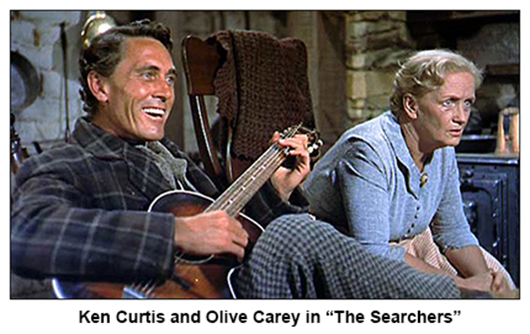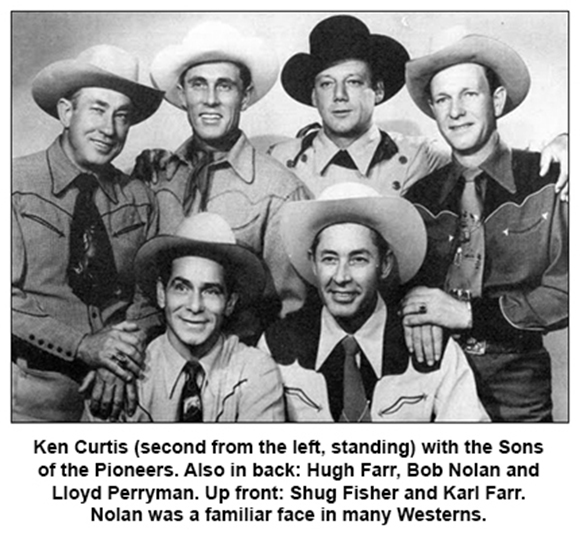| HOME |
 |
|
|
Before there was Google, people fed their curiosity and settled bets by calling their local newspaper. I was reminded of this recently when I re-read a story about my phone interview with actor Ken Curtis in 1964. The story was as much about the calls we received from our readers as it was about Curtis, because as luck would have it the actor was the subject of several questions that were puzzling Akron-area residents. As the story explained ... |
|
|
|
After "Gunsmoke," Curtis had guest roles in several prime time series before becoming a regular on "The Yellow Rose," a contemporary Western soap opera that starred Sam Elliott, Cybill Shepherd and David Soul. It ran one season (1983-84). Joining Curtis in the supporting cast was Noah Beery Jr., who had been so memorable previously as James Garner's father on "The Rockford Files." Curtis died in 1991, suffering a heart attack while he slept. He was 74 years old. He was survived by his second wife, Torrie Ahern Connelly, whom he had married in 1966. |
|
 |
|
 |
|
 |
Some actors, even those who had been in Hollywood for many years, found their best roles in television. Milburn Stone, who made his first movie in 1935, had done more than 150 of them before he was cast as “Doc” Adams on “Gunsmoke” in 1955. He would be featured in more than 600 episodes over the next 20 years of one of television’s longest-running programs. Stone had played every kind of role imaginable in every kind of film imaginable, but he’ll always be remembered as the Dodge City doctor and close friend of Marshal Matt Dillon. (“Gunsmoke” had been a radio series for many years. In that version “Doc” Adams was played by Howard McNear, whose best-known television role was a Floyd the barber on “The Andy Griffith Show.”) I had the opportunity to interview Stone – well, I was one of many journalists who talked to him press-conference style – in Chicago in 1964. This type of interview, if it can be called that, is often worthless. Only a few actors can make them interesting (see Robert Conrad), and Stone’s session went off the rails when a young woman from a Wisconsin newspaper was overcome by emotion when she attempted to ask a question. Turned out Stone was a special favorite of her parents, which made the actor one of her idols, and she was reduced to tears. The press conference never recovered. Considering his 40-year career in movies and television — starting with an uncredited appearance as a sailor in 1935's "Ladies Crave Excitement" — Stone almost certainly would have been great in a one-on-one interview. He worked in 169 movies and TV shows, but "Gunsmoke" took up more than half his working hours. He appeared in an incredible 605 episodes of a series that ran from 1955 to 1975. He made only brief appearance in many of his films, and he was in a wide variety, most of them "B" movies that were the opening attraction in double features. He did show up in some "A" films, including "Made for Each Other" (with Carole Lombard and James Stewart in 1939), "Johnny Apollo" (with Tyrone Power and Dorothy Lamour in 1940); "Cass Timberlane" (with Spender Tracy and Lana Turner in 1947)' "Operation Pacific" (with John Wayne and Patricia Neal in 1951), and "The Long Gray Line" (with Tyrone Power and Maureen O'Hara in 1955). In that last one, Stone played John J. Pershing when he was a captain, serving at West Point. Never a major film star, Stone eventually became as famous and well-recognized as most of the bigger names in Hollywood. And because he was a fixture on television in the same role for 21 years, many Americans came to regard him almost as a member of the family. Stone retired when "Gunsmoke" went off the air in 1975, and died five years later in San Diego. He was 75 years old. He was survived by his wife, Jane Garrison, whom he married in 1939, divorced a year later, and re-married in 1941. She was his second wife. His firsdt was Ellen Morrision, who he married in 1925. She died in 1937. |
 |
| HOME • STARSTRUCK • CONTACT |
